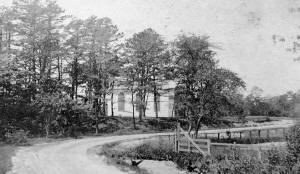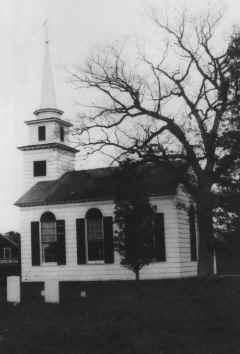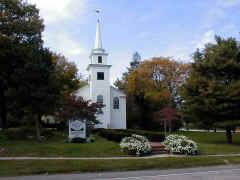"This is a living Church of Jesus Christ. This is a building and a congregation in which are enshrined the vital traditions of America -- preserving and projecting the living fact of Christ and the living fact of America."
The Rev. Charles Kellogg, shortly after the building was moved and restored in 1960.
The History of the Old South Haven Church
While it is not definitely known when the Old South Haven Church began to worship, most probably the organizer was The Rev. George Phillips about the year 1717. At that time the "Town" church was situated in Setauket, NY on the north shore of Long Island. The growing settlement on the south shore of the Town of Brookhaven found traveling to worship in Setauket very difficult.

The 1828 building as it appeared on South Country Rd. about 1900. This is the oldest picture found so far of the church.The first building was erected about 1740. It is thought that this original structure burned to the ground or was otherwise destroyed. Evidence suggests that a second structure was then erected which survived the Revolutionary war, although it was said to have been abused by the British. In 1828, this structure was replaced by the present "meeting house." There is evidence that timbers from a prior structure was used in the new building; some suggesting that the 1828 building was more in the nature of a complete rebuilding of the Colonial era building rather than a totally new structure. In any event, the 1828 building was relocated to a site a short distance to the east of the earlier meeting house.
The first resident minister seems to have been Nehemiah Greenman in 1748, then followed by Abner Reeve, but it was the third resident, David "Priest" Rose, who is most fondly remembered. David Rose was born in Connecticut and educated at Yale to be a doctor. It is not known why he later turned to the ministry, although his medical knowledge enabled him to minister to bodies as well as souls. He provided great leadership to the church during the trying years of the Revolutionary War. His sermons and influence did much to arouse a sacrificing patriotism among members, and it is recorded that at a congregational meeting on June 13, 1774, with Wm. Smith as Moderator, it was voted that: the Act of Parliament for blocking up the port of Boston is unconstitutional and has a direct tendency to enslave the inhabitants of America; that the Colonies should unite and adhere to a non-importation policy from Great Britain and the West Indies, and have no trade with them; that certain persons be a standing committee to correspond with the Committee of Correspondence in the city of New York, and that these sentiments be communicated to them.
Many members of the Old South Haven Church subsequently played dramatic parts in the Revolutionary War. Colonel William Floyd, who became a General, sat as a representative from the Province of New York at all sessions of the Continental Congress. He urged adoption of the Declaration of Independence and signed it, the same bold signature which can be seen on the first pages of the records of the church. For his loyalty to the rebel cause, his beautiful estate in Mastic was ruined by British soldiers.
Colonel Nathaniel Woodhull, who also became a General under George Washington, proved to be one of the first notable martyrs to the American cause. He had been the first president of the rebel Provincial congress of New York that had defied the English Governor Moore, and which executed the orders of the Continental Congress. Commanding a rebel force on Long Island, he was captured by the British. He was ordered to humiliate himself by declaring, "God save the King!" But he replied, "God save us all!" A soldier struck him with a sword and he died of his wound.
Judge William Smith, Lord of the Manor of St. George, was also active with the rebels. He took the place of General Floyd in the Provincial Congress of New York when Floyd became delegate to the Continental Congress. He was a member of the group which in 1777 framed the state constitution of New York. Having been forced to flee by British invasion, the British used his estate for military purposes, making his home Fort St. George. It was later recaptured by 80 Americans in a surprise attack launched from Mt. Sinai on the north shore.
Colonel Josiah Smith, another member of the Old South Haven Church, led a regiment in the Battle of Long Island. It was with this regiment that Rev. David Rose fought.
The Old South Haven Church did not fare well during those war years. Its pastor and most of its members were either away fighting the British, or in exile. The meeting house was employed by British soldiers, after they had thrown out the pews, as a stable for their horses. One tradition states that the loft of the church was used as a barracks; however, there is no evidence that the structure even had a loft.

The church while still in South Haven, probably about 1930. Montauk Highway is to the left. A few of the cemetery stones can be seen in the foreground.It was not clear precisely when the first church was destroyed, but the records do show that the present structure was built in 1828 during the distinguished ministry of Ezra King at a cost of $1,959.04. This compares somewhat favorably with the 1960 restoration cost, including property, of about $50,000. The construction in 1828 was partially financed by the sale of pews, which later proved to be an embarrassment, for in 1899 we hear The Rev. Frederick Frisbie pleading "that all hereditary rights to pews be given up." There was no place to seat visitors!
One of the more distinguished visitors at worship was the Senator Daniel Webster. A common tradition relates that Webster had been trying unsuccessfully for some time to hook a huge trout which he had heard was in the river. One Sunday morning he had come to the church, and in the middle of Ezra King's sermon, was informed in a loud whisper by one of Sam Carman's servants who had entered, that the big fish had been sighted in the pool below the mill. Webster tiptoed out, but was followed by a multitude, including the minister who pronounced a hasty benediction. Daniel Webster caught the trout, some 14½ pounds, and since there were no cameras, the fish was held against the wall of Sam Carman's hotel and its outline drawn there. A blacksmith, copying it, carved a weathervane out of cherry wood, one-third larger than the fish. He gilded it, and placed it on top of the church spire. There it remained until struck down by lighting, and the original carving is now exhibited at the Bellport-Brookhaven Historical Society; and a replica can now be found on the church spire. As for the fish, tradition states that it was taken to Delmonico's where it was devoured by the Senator and his friends.
The Rev. King's interest in education caused him to establish an academy in neighboring Bellport, the "Bellport Classical Institute." The building is now used as a private residence, although the street retains the name of Academy Lane.
While the design of the 1828 church building was similar to the present structure, there were several notable differences. The entrance to the meeting house was through two doors on either side of the steeple (there placement is still visible on the inside walls), and there was a "high" pulpit between them beneath the steeple, with the pews facing the entrances (there was no balcony). Late arrivals and early departures would have been in full view of both minister and congregants.
During the 19th century, the interior of the church building was twice remodeled. In 1861, the two door entrances were replaced by a single entrance through the steeple, a balcony and narthex erected, the direction of the pews reversed, and a lower pulpit platform placed at the opposite end. It was at that time that the clock, which still is placed on the balcony rail, was given by Samuel Carman, Jr., and two Hepplewhite chairs were donated by Mrs. Mary Floyd Ireland for use in the pulpit (these chairs eventually became too fragile for regular use, and are now on loan to the Bellport-Brookhaven Historical Society). In 1873 or 1874, lightning struck the steeple and severely damaged it. This event initiated a second remodeling. The steeple was repaired to its present appearance, the "Amen benches" to the right of the pulpit were replaced by a choir box, and the interior painted a drab brown with a border, popular with the Victorians.
In 1939, during the pastorate of the Rev. George Borthwick, the interior received its third remodeling. The "Amen pews" were restored to the right of the pulpit, the interior walls and pews were repainted to the original off-white, and a new pulpit reading desk installed. The general appearance of the church was again similar to its early 19th century style -- the principal differences being the orientation of the pews and pulpit, and the presence of a balcony.
On October 18, 1945, the parish accepted the Brookhaven Methodist Church property on Beaverdam Road (and in a separate coordinated transaction, the Methodists accepted the independent Bellport Presbyterian Church property.) The old Methodist Church building had better facilities for worship and meetings, and by 1960, the old South Haven Church building was unused and in need of repairs.
On December 29, 1960, under the leadership of the Rev. Charles Kellogg, the historic South Haven Church building was moved from its original location at the "goin' over" of the Carman's River, to its present location in Brookhaven. As part of this transaction, the church acquired and renovated the Post Carriage House (built about 1900) which became the congregation's Parish Hall. An addition was added to the rear of the main church building, and two entrance doors were added from this room to the main church. On completion of renovations, the Brookhaven Church building was sold and is now a private residence.
These were some of the great names associated with Old South Haven Church, and some of the more dramatic events in the live of the parish. More important by far is the long list of members and friends through the centuries who have worshiped in this congregation and who have made sacrifices that it might live and continue Christ's work. These are our spiritual ancestors, the communion of saints, and what they began we shall dedicate ourselves to carry on./p>
First to Almighty God, and then to one another, let us express our gratitude for the hundreds of persons who have contributed so that the past might continue to live and inspire the future.
| Much of the material in this brief History was adapted from a Pamphlet prepared by the church on the occasion of it's rededication following its move in 1960. Revised: March 21, 2012 |
